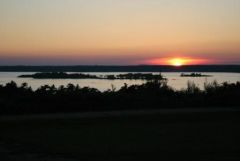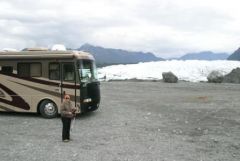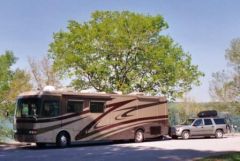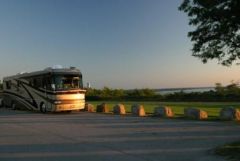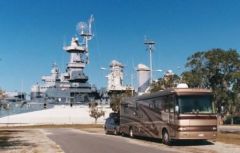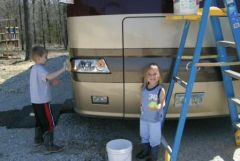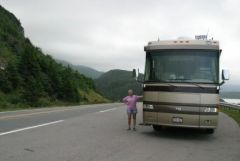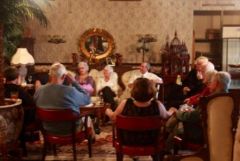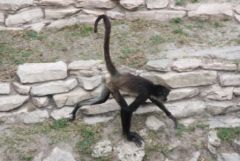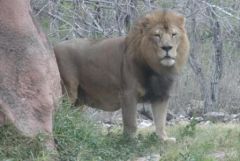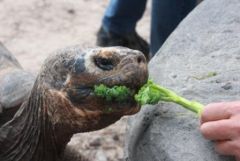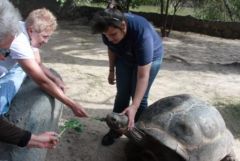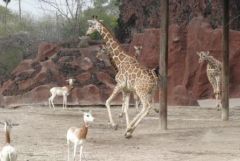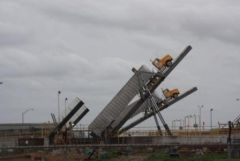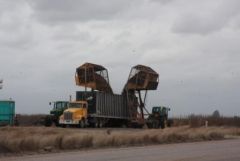-
Content Count
2713 -
Joined
-
Last visited
-
Days Won
44
Content Type
Profiles
Forums
Blogs
Gallery
Everything posted by tbutler
-
In China this is the year of the Tiger. Here in South Texas it is the year of the puddle. We are in temporary digs at our winter resort. We sold the improvements on our home lot for the last several years and moved to a different lot until we can get a mobile home on what will become our home address in coming years. So, we are right across the street from the office and community room near the entrance of the park. It is the "oldest" part of the park and the roads are beginning to show it. Now in a normal year, you wouldn't notice, but the winter of 2009-2010 hasn't been normal. If you haven't heard, this winter has been an El Niño year. A surface current in the Equatorial Pacific Ocean has disrupted normal weather patterns and everyone notices this in one way or another. Southern California gets heavy rainfall. There is flooding Las Vegas. Record snowfalls are recorded across the United States and snow is falling in unusual places. El Niño, for those who aren't familiar with it, is an unusually warm surface temperature that occurs every few years. This year, the outbreak has been characterized by a very strong (5 degrees above normal), long-lasting outbreak that covers a very large area. You can learn more about El Niño at the National Oceanic and Atmospheric Administration web site. Click on the words El Niño in blue and you'll see a depiction of the recent activity. The good news is that the temperature difference is currently about 4 degrees above normal for most of the warmest area. That is a tiny bit closer to normal! Funny how all that warm water way out there in the Pacific Ocean could dump so much snow and rain on the U.S. It just illustrates the complexity of the climate and weather of this wonderful planet Earth. So all that has translated into this puddle in front of our motorhome. It fluctuates, one day small, the next day large. Once in a while it disappears only to pop up again the next day. The puddle comes from rain that doesn't drain away. Instead it drains into the road and there it sits in low spots. When we leave the coach we have to plot a course around the puddle or in some cases between puddles. This contrasts with last year when we had hardly any rain at all. We were constantly under fire hazard warnings and open burning was prohibited for weeks at a time. We've had plenty of rain here in South Texas this winter. Despite all the rain and the puddle, we know we have it good. A phrase often heard around the park is, "At least we don't have to shovel it!" As long as El Niño continues we can all expect unusual and extreme weather. It could be a real exciting spring!
-
Welcome Jim, You'll get a more complete answer from others I'm sure. In general, what you are describing is exactly what should happen with the exhaust brake. With our coach the hard downshift doesn't occur immediately, there is usually a period of time before the transmission downshifts. When you take the brake off the transmission will upshift in response to engine RPM. You can downshift without using the exhaust brake, just use the down arrow on the transmission. If the engine RPM is in a range that allows the transmission will downshift. You can not damage the transmission by using the downshift arrows as the transmission will not allow the engine RPM to go higher than is safe for the engine. Downshifting from 6th gear to 5th gear will slow acceleration going down hill without the engine brake. In ordinary hills, I seldom use the engine brake. As long as your speed remains in a safe and legal range, let the coach accelerate and then let the next up hill stretch slow the coach to your desired speed. To use the brakes excessively is a waste of energy. Try downshifting to control the speed and then use the engine brake if necessary to hold speed where you want. If you do use the engine brake, release it before you reach the very bottom of the hill to make the best of the acceleration the hill can give you. With a little practice you can use this technique to improve your fuel mileage.
-

Idyllic settings for motorhomes
tbutler replied to stevegoldberg1@gmail.com's question in Destinations/Attractions
We've found many of those places in our years of travel. My favorite was at the toe of the Matenuska Glacier in Alaska. There is a campground there but nothing sufficient for a motor home of our size so we requested and received permission to boondock on the overflow parking lot which overlooked the end of the glacier. We were a short 200 yards from the ice. We stayed at a number of other roadside stops in British Columbia, Northwest Territories and Alaska at which we were the only occupants. Occasionally we would share a roadside stop with another RV or two. We saw the northern lights one night at a roadside stop where no other lights could be seen anywhere on the horizon! We parked next to a river and enjoyed the sights of watching float planes land and take off. That night we discovered we had taken in several dozen mosquitoes and they feasted mightily on us during our sleep. We killed many but found many others in the covers the next morning! We were the only RV parked at a roadside stop in New York, Highway 132 overlooking the St. Lawrence Seaway. We BBQ'd and watched the sun set over Canada. A ship we had seen in the Eisenhower Lock earlier in the day passed by us as we ate dinner. We spent the night there without any other company. These are just a few of the interesting places we have stopped. We've spent many a night in humble RV parks and in very nice RV parks. We enjoy meeting people and learning from them. We also enjoy those special moments when we are all alone in a natural area. -
-

Sunset from our overlook on the St. Lawrence Seaway.
tbutler posted a gallery image in Members Gallery
From the album: Look for us on the road!
The sun sets over Canada and the St. Lawrence Seaway. We spent the night at this roadside rest area in New York. There is an accompanying picture in this album showing our rig and the view of the seaway.© @ Tom Butler
-
From the album: Look for us on the road!
We spent the night here overlooking the Matanuska Glacier east of Parker, Alaska. We hiked onto the toe of the glacier in the evening and again in the morning before we left. During the night we could hear the moaning of the moving ice. The campground there didn't have any sites suitable for a big rigs so we asked permission to park here in what is their overflow parking lot. We were the only motor home parked here for the night. We paid a camping fee to boondock but it was worth it for the experience.© @ Tom Butler
-
Welcome to the Forum. So I assume, Jack and Jane, you are retired! I can also assume that you are somewhere in the southern US to post this message at this time! How long have you been on the road? Where have you been? So fill us in on your travels what are the activities that you enjoy most. You might want to start a BLOG where you can give us your story in installments!
-
Trader Buzz, I'm going to refer you to my posting from almost a year ago. I briefly thought about projection TV but it really wouldn't work for us. I replaced the old 24 inch analog TV with a 32 inch flat screen. Wow! What an improvement. Then I traded in the old analog DTV box for a digital and that completed the conversion. I did the same with the rear TV, routed a second feed from the new KVH dish we purchased (not HD capable) to the bedroom TV which was a 26" LCD replacing a 20" analog TV. Now we can watch two different channels. We're very happy with the results.
-
Our set up is different so our experience will have some differences. We have four 6V batteries and an 7.5 KW diesel generator. We boondock frequently, most times on road trips, parking at Wal-Mart, rest stops and other parking areas with no services. Two years ago we were in Jasper National Park and could only get a non-electric site. We've been in cold weather with no hookups on a fairly frequent basis. Here is how I would approach a typical day. Rising in the morning, the coach will be cool to cold because you will set the furnace at a temperature like 55, 60 or 65 degrees for overnight. The lower you can stand to set it, the less the furnace will run and the better your battery life. Bring plenty of blankets and be prepared to live with the cooler indoor temperatures. For five nights you could even sleep in some good sleeping bags. You run from the bedroom to start the generator, turn the furnace up to a comfortable temperature, turn on the coffee pot which you have preloaded the night before and then jump back into bed to let the furnace do its work. Depending on your neighbors, you may do this at 6:00 a.m. if they are all motor homes and have generators that are running. If you have tenters in the neighborhood, 8:00 a.m. would be more considerate. If the sun is shining, open the curtains to let the sun shine in and assist the furnace. Once you are up and about, turn on the TV if you desire to pick up the latest news and a weather forecast. Get breakfast while the generator is running. We switch our refrigerator to electric when the generator is running as the electric cools our refrigerator better than propane. It takes about an hour and a half to do all this and in that time the batteries are in real good shape. Shut off the furnace or turn it down again, switch the refrigerator to gas, lights off and exit the house leaving curtains drawn if the weather is cold and cloudy. If the day will be sunny and you'll be back well before sunset, leave the curtains open to get as much solar heat as possible. Enjoy your day. When you return note the temperature of the coach and when you see it starting to drop, close the curtains if they are open. Start the generator, switch the refrigerator to electric if that is better for your fridge, cook, run the furnace, catch up on news and weather on the TV, read, etc. About a half your before turning off the generator, set the furnace temperature up several degrees to warm the house well. Then turn the temperature back to a comfortable evening temperature if you are going to stay up and read, etc. At bed time set the furnace back as cool as you can tolerate and go to bed. You want to be sure you have a good charge on the batteries before a cold evening as the night is going to be the real test of your batteries. I run our generator for several hours in the evening to be sure I have a good charge on the batteries. We also have good indicators of battery charge with our instrumentation so I always check that before shutting down the generator. A few nights at this and you'll be a pro. You'll know how well your batteries handle the furnace for a given outdoor temperature and thermostat setting. You might luck out and have nice weather with sunshine and moderate night temperatures. Five days is a short stay at Yellowstone. You may want to stay even longer! Enjoy!
-

Towing vehicle heavier than 3000 lbs
tbutler replied to dm3497@aol.com's topic in Toads-Towed Behind Motorhome
If the Fleetwood is rated to tow a 3000 pound vehicle then that means that some component of the system is only capable of supporting that weight. This rating is most likely rated on a repeated stress basis, not just a single event. The component could be the hitch but it could be another component, frame, engine, drive train, brakes. Brakes would not necessarily help with the stress on a specific component. You should have the Honda weighed to determine its exact weight. If you are going to load the trunk, the back seat, or use a car top carrier, or put bicycles on the back, you should have them on when you weigh. Weigh with a full fuel tank. If you fully load it and it comes in under 3000 pounds you are OK. If not, your insurance company (they will have the specs on the Fleetwood) would likely use the overage in weight to deny any claim in the event of an accident. In court, that 50 pounds you mention could cost you the value of the Honda. If an accident causes additional damage to other property, you could be liable for that as well. Basically if you exceed that rating, you are on your own. How rich are you? -

Aid for Haiti - An interesting connection with FMCA
tbutler replied to tbutler's topic in General Discussion
Jim, You say you want no replies to your post but you pose a question and I will try to answer that question. First, nobody gets flamed on this web site. Well, almost nobody. Like you, I am a veteran and like you I feel very strongly about those in need in our own country. I have spent a career in education, doing my best to help children learn to be better citizens, better learners and better workers to support their future families. During that time I have contributed to many organizations that support those in need in this country. I don't see the issue as an either/or situation. I see hundreds of thousands of dead in Haiti, about 100 dead for every person who died in the attacks on September 11, 2001. I see those dead in a country that is one of the poorest countries in the world and I know that there is no way they can support themselves or recover from such a tragedy. Without help, hundreds of thousands of others will certainly die. To fail to help them is to invite further tragedy and human misery on a scale that even the poorest people in this country can not imagine. Just as you feel an obligation to help those around you who are in difficulty because of lost jobs and homes, the richest nation on earth is obligated to help those throughout the rest of the world who are poor and destitute. "From everyone to whom much has been given, much will be required; and from the one to whom much has been entrusted, even more will be demanded." (Luke 12:48) Despite our current difficulties in this country, all of us here in the United States of America are still among those to whom much has been given. My service in Viet Nam and visits to other third world countries and travels in Europe have clearly shown me how much we have been given. I think it is important to help those in need wherever they live. We are in many cases the only country capable of giving the aid necessary. What is important is that each of us helps those in need of help in accordance with our conscience and ability. -

Advice for storing our motorhome for three weeks a month
tbutler replied to arosen2176@msn.com's topic in Type A motorhomes
Are you living where freezing temperatures are a concern? -
Increasing dues is seldom done without careful consideration of the consequences. Every dues increase will cause some members to drop out. Will enough members stay to more than offset the lost members? Will we lose more members by cutting this service or that service? The board meeting at Bowling Green, Ohio, last summer lasted for more than 12 hours, I believe. Our officers and board are wrestling with some difficult decisions. I believe that there has been a reduction in the paid staff at headquarters. I don't have specific numbers on the top of my head, but I'm sure someone can supply those numbers. We've had comments on the increase in the mail forwarding fees charged to members. Reductions are being made where possible. For myself, I'll renew for the maximum multiple year renewal allowed and thus lock in the current dues for the next five years. It might seem that the organization is losing my dues for the coming years, but in reality they are getting a big payment now. That money can be invested to earn some of the difference between the old dues and the new dues. Every member is making difficult decisions these days. What to keep, what to let go. We'll hope that most of the members will keep FMCA, but for some, the $5 will be the straw that breaks the camel's back. That is an accepted part of the decision to increase dues.
-

Waco, TX to Mt. Rushmore, SD
tbutler replied to RollingRealtor's question in Destinations/Attractions
Welcome to the forum Rolling Realtor, I checked with my GPS program. There is no interstate route that is anywhere near direct so you'll be taking some US highways to get the shortest route. I haven't driven all these roads but my experience with the US highways in the region indicate that they should be very passable. You will find them to be more interesting to drive than the interstate, you'll have to watch for signs particularly in towns as they weave and wander through small towns. Just take it easy (don't rush) with the motor home and you'll do fine. Get out your map and see how this route works for you... From Waco you can take I- 35N to Oklahoma City. You can pick up US 270N just west of OK City, at Seilling OK you would then take US 183N to I-70W OR If you prefer you could stick with I-35N to Wichita, KS where you would continue N on I-135 to Salina, KS where you could take I-70W. This route is a little longer but would be interstate all the way. The distance is greater but the time may be about the same! Your next challenge will be to get to I-80 in Nebraska. Again, no interstate route even close. Go west on I-70 to Wakeeney, KS and then turn north on US 283 which will take you to I-80 at Lexington, NE Take I-80W to US 385N at Sidney, NE and stay on US 385 to SD Hwy 79N to Hermosa, SD At Hermosa, take US 40 W to Keystone and then SD Hwy 16a south to Mt. Rushmore Simple as that! OR You could take I-35 N to Kansas City, MO, then I-29 N to Sioux Falls, SD and I-80 W to Rapid City where you would take SD Hwy 79S to Hermosa and US 40W to Keystone and then SD Hwy 16a south to Mt. Rushmore. The distance on this route is a little longer than the routes described above. My GPS programs shows it to be about 156 miles longer, 1216 vs 1372. I can't imagine it taking more time plus the driving should be about a simple as it can be. Plenty of big cities, either take the by-pass route or navigate the city traffic at non rush hour times! When I'm driving routes like this (you indicated you want to spend more time at Rushmore than on the way) I like to travel 300 to 400 miles in a days driving. It looks to me like this could be easily driven in three days. We never stop at campgrounds when driving for distance. Kansas has great rest stops along the interstate with dump stations. We stay at highway rest stops if we can't find a Wal-Mart that is convenient. If not Wal-Mart, we'll look for large parking lots by empty store buildings and park on those if it isn't posted. Truck stops are way too noisy for us but if we are desperate we'll use them as well. If we go into a campground, it cuts into the travel day and that takes us longer to get to our destination. Rushmore itself is a day visit. While in the area, be sure to see Custer State Park for the bison. The Black Hills have many opportunities for hiking and fishing. Near the town of Custer is the Crazy Horse Monument being carved (blasted) out of stone. There is a great museum there also. We have hiked up onto the Crazy Horse statue with Volksmarch on two separate occasions. They sponsor a walk onto the outstretched arm of Crazy Horse each spring. Don't miss that if your schedule allows. You'll be a short drive from Badlands National Park and that is something not to be missed though it can be intolerably hot in the summer. Wind Cave National Park just south of Custer State Park is also a great cave adventure and Jewel Cave National Monument to west of Custer is also interesting. There is a great excavation site at Hot Springs, SD that has mammoth bones exposed in their position where found and a nice museum to go with it. There are many interesting things to see and do in Rapid City and Sturgis is just north of Rapid City but don't go there during the Motorcycle Rally unless you really like crowds of motorcycle riders and their fans! We stayed at the Custer/Crazy Horse RV Park just east of Custer on SD 16 Alt. That was in 2004! We found the park to be quite adequate and it was within a days touring of all the things listed above. -
The FMCA Parking Committee usually asks that you limit the use of your toad during the coach parking days. If you do need to go somewhere they will have specific exits and entrances for you to use to avoid conflicting with the coaches arriving and parking. Once the convention is underway and everyone is parked then you can come and go freely. The local community may be planning special events for attendees. In Bowling Green last summer we saw the latest Harry Potter movie one afternoon, had pop corn and soda and still paid less than we would have for a single ticket where we are now! They also had a sidewalk sale during the convention. Be sure to look for activities in town!
-

We're Not Getting Any Younger ...
tbutler replied to bernhardbus@verizon.net's topic in Modifications
Do you have pictures of your work? You could post them in a forum entry or in the photo section. Be sure to include some description of what we are seeing. Before and after pictures would really be nice. I don't need this done with our coach ... yet! I'm sure we have members who would be interested. -

Where to stay in Colorado in spring/summer
tbutler replied to bertieparker07@comcast.net's question in Destinations/Attractions
We don't have a lot of information about you. Your personal profile is empty. I wonder what your interests are. Do you want to see the natural areas like the Black Canyon of the Gunnison or Mesa Verde? Are you more interested in seeing the ski areas and riding gondolas and shopping? Would you be interested in the Mint in Denver or the fossils in Florissant Fossil Beds National Monument? Some people are interested in the Casinos around Central City and it is a hoot to attend the opera in the old opera house in Central City. We enjoyed a trip across old Hwy 40 in the northern part of the state. We never saw any speed traps but then I watch my speed like a hawk, after all, I'm always an "out-of-town'r." Seriously, if you give us some idea of your interests we might have better, more relevant suggestions. We haven't stayed in the campgrounds in the area but near Alamosa in the SE corner of the state is a mecca for RV's in the summer. Near Alamosa you will find the headwaters of the Rio Grande River with fishing and rafting. There are lots of parks along US 160 west of Alamosa. It looks like many of them are people who are summering in the area so there will be long term residents. The altitude makes the climate moderate. There is plenty to be seen in the southern half of Colorado and you will be within a day or two drive of most of it. You may want to settle in that area for a while and then explore out from there. -
These are pictures from three trips we took in January 2010. The first trip on Wednesday, January 27 was to the Cowley Sugar House and Mill in Santa Rosa, Texas. We learned about the growing, harvesting and processing of sugar. The second trip was on Thursday the 28th to the Gladys Porter Zoo in Brownsville, Texas. We took a behind the scenes tour of the zoo. The final trip was to the Port Isabel Yacht Club Hotel and Restaurant in Port Isabel, Texas. We had dinner and some of us stayed overnight.
-
From the album: Winter Trips in the Rio Grande Valley
Members of our group visit in the lobby of the Port Isabel Yacht Club Hotel and Restaurant. This was the third outing in three days exploring the southern tip of Texas.© @ Tom Butler
-
From the album: Winter Trips in the Rio Grande Valley
We are ready for some fine dining at the Port Isabel Yacht Club Hotel and Restaurant.© @ Tom Butler
-
From the album: Winter Trips in the Rio Grande Valley
The Gladys Porter Zoo takes in many abandoned pets including a full exhibit of spider monkeys.© @ Tom Butler
-
From the album: Winter Trips in the Rio Grande Valley
This pigmy hippo was pacing his cage.© @ Tom Butler
-
From the album: Winter Trips in the Rio Grande Valley
This Mandrill is an old world monkey, one species of hundreds that live in Africa and Asia.© @ Tom Butler
-
From the album: Winter Trips in the Rio Grande Valley
This is the male lion that was roaring and excited the giraffes and many other African animals nearby.© @ Tom Butler
-
From the album: Winter Trips in the Rio Grande Valley
Up close and personal with a Galapagos tortoise© @ Tom Butler


